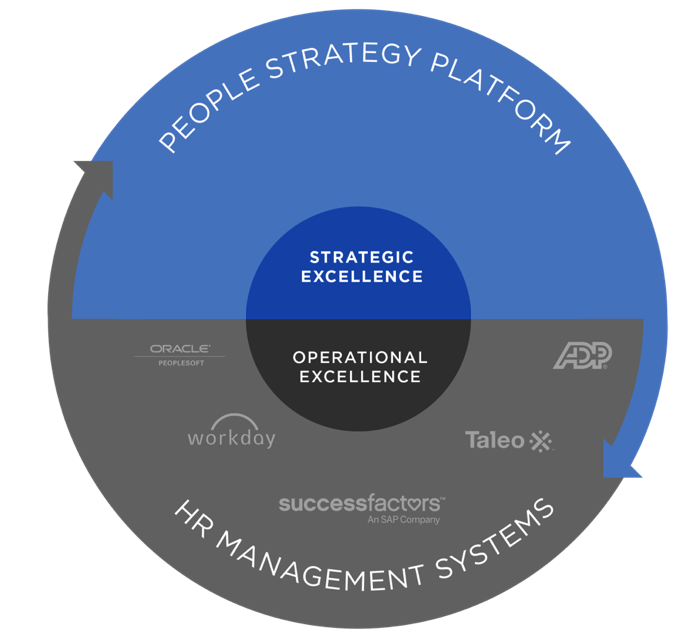The Rise of the People Strategy Platform
With the rise of the People Strategy Platform to enable strategic excellence, HR organizations have more ability to create value for the business.|With the rise of the People Strategy Platform to enable strategic excellence, HR organizations have more ability to create value for the business.

The idea that great HR functions are strategic is not new. But the link between people and business strategy has never been clearer: The pandemic has accelerated digital transformations, and this means that “a lack of digital skills could jeopardize companies with misaligned talent plans,” according to Gartner.
Why do you need a people strategy now more than ever?
A sharp shift in a company’s core business model is just one example of how the success of the business strategy depends on the people strategy. Today’s business environment is more complex and uncertain than ever before, and it requires:
collaborative, remote workplaces
trusted, empathetic leadership
simplified processes and budgets
To position the business for resilience, it takes an HR leader who can navigate the nuances of human dynamics, cost pressures, and the changing business environment with confidence.
How does a people strategy drive business outcomes?
Consider how First West Credit Union tried different interventions to reduce their turnover: pay increases, improving onboarding, training managers to set reasonable career expectations, and additional training. They then did an ROI analysis on each intervention and found that upskilling their retained employees with additional training led to increased revenue–$200,000 per retained employee and a total return of $2.5 million.
Clearly, an effective people strategy–delivered through evidence-based decisions–can have a major impact on financial performance. But it’s not just a matter of HR delivering on a fully baked business strategy.
As stated in this BCG paper: “Developing a people strategy was once a straightforward matter of figuring out how to create the best possible workforce to execute an already defined business strategy. But…people strategy today involves much tougher choices and tradeoffs. It may actually drive the business strategy as much as business strategy drives it.”
Challenges faced by HR
Given that people strategy may actually drive the business strategy as much as business strategy drives it, what has held HR back from achieving this?
1. HR systems are built to enable operational excellence, not strategic excellence
HR has long focused on achieving operational excellence. This has included many multi- (multi-!) million dollar investments in systems that manage and automate HR tasks, act as systems of record, and help HR execute on administrative activities faster, with fewer errors.
HR management systems, applicant tracking systems, performance management systems, talent management systems, payroll systems. The list of systems that were built to enable operational excellence in HR goes on and on.

But these systems — while they generate lots of data — are capable of not much more than operational reporting. These transactional systems cannot effectively answer strategic workforce questions, connect workforce decisions to business outcomes, or support future modeling and projections. Their underlying technology simply does not allow it in any meaningful way.
Take Workday as an example, where the underlying transactional technology cannot support analytics:
Workday has had three “at bats” in its attempt to provide more than basic operational reporting to its customers. In all three attempts, Workday had to look to third-party technology, as the Workday transactional technology is not capable of supporting analytics.
Attempt 1 was Workday Big Data Analytics — announced in 2012, Workday hoped to leverage a third-party analytics technology (called Datameer) to “provide pre-packaged analytics that enable customers to combine Workday data with third-party data sources of any type, including big data, all delivered in the cloud.”This attempt failed, and was replaced with Workday’s next attempt: in 2014 Workday acquired Identified, an analytics technology company, and announced its plans to use Identified’s technology to “create a new suite of applications that will harness the power of advanced data science and machine learning algorithms to equip customers to make smarter financial and workforce decisions.”This attempt also failed.
In 2016, after a lack of pick up by customers and inability to deliver on its analytics promises, Workday acquired Platfora, a data discovery tool that Workday hopes will help customers “bring more data into Workday.” In its attempt number 3, Workday is trying to solve the problem of bringing more third-party system data into Workday. But it is unclear what will happen when it eventually gets there — if it does — and, once there, how that data will be analyzed.
The short story — even the great transactional HR system vendors are struggling to figure out analytics. Success requires deep expertise, the right technology, knowledge around what questions to ask and how best to answer them, and the ability to bring data together from many disparate sources (including business data) with ease.
2. HR has been underserved by IT
Many HR teams have striven to put the data being generated by their HR systems to good use. They’ve done this in two ways.
One common approach is to call on IT, who typically responds with “you need a data warehouse first” — often a multi-million dollar, multi-year project that focuses on cleaning and integrating data.
Once the data is ready, IT professionals, using business intelligence and data discovery tools, then create dashboards and scorecards — only to find that the questions HR and the business care most about are not being answered, the delivery of the insights is insecure, and the data is out of date. Not surprisingly, these projects have high failure rates.
Another approach is to tackle the problem within HR — through reporting staff and, if fortunate, data analysts. But these individuals are equally hamstrung by the capabilities of the systems and tools they use. Often after an initial success with dashboards for leaders, the function hits the wall and is unable to scale to support the needs of the business.
How to achieve strategic excellence?
The people strategy platform complements investments in HR transactional systems by bringing together the data from those systems — and from business systems — to answer important questions that connect people to business results.
Focused on providing strategic insights to make better people decisions and plans, and connecting those decisions directly to business outcomes, the people strategy platform enables strategic excellence within HR.

Here are a few examples comparing the role of a people strategy platform to the role of your transactional HR systems.
HR Management Systems: Enable Operational Excellence | People Strategy Platform: Enables Strategic Excellence |
Track applicants efficiently |
|
Administer compensation and manage payroll accurately |
|
Report headcount changes |
|
Capture performance reviews and trigger rewards and recognition programs |
|
Process entries and exits |
|
Key features of a people strategy platform
To achieve the strategic insights listed above, a people strategy platform–at a high level–must include these critical capabilities:
1. Answers the right questions
Your people strategy platform should answer best practice questions across HR topic areas, without any development or manual data analysis on your part.
To do this, the solution should bring together data from all your disparate HR systems for you, mapping that data to answer the library of best practice questions.
Whereas your various HR systems are data islands, your people strategy platform is a central hub of insight, bringing all the data pieces together to answer the most important and valuable questions.
2. Connects to people to business outcomes
Your people strategy platform should connect people data to business data for you — enabling better decisions by answering questions about how people decisions drive business results.
For instance, you should be able to see which employee factors relate to improved revenue or customer satisfaction, and be able to explore these insights in real time to understand the levers you could pull to improve business results
3. Covers the past, present and future
Your people strategy platform should show your historic trends, what is happening today, and be able to forecast the future.
This includes being able to base predictive analyses on historic data that goes back more than a year, preferably several, as well as supporting future workforce modeling, scenario comparison, and planning.
4. Shares insights clearly with stakeholders
Your people strategy platform should enable secure sharing of insights and plans with stakeholders in a way that’s easy to understand. Insights shared should be based on up-to-date data, preferably not requiring manual effort to update; as well, you should be able to “drill into” insights and answer new questions interactively in real time
5. Enables collaborative, cost-driven planning
Your people strategy platform should allow you to create cost-driven workforce plans collaboratively, involving stakeholders across your enterprise.
Workforce planning should be based on an accurate current snapshot of your organization, take into consideration all workforce costs, include financial limits, consider historic workforce trends, and allow for scenario modeling and evaluation.
Now is a great time to be in HR. With the CHRO as a key power player in the C-suite, and the rise of the People Strategy Platform to enable strategic excellence, HR organizations have more ability than ever before to create value for the business.


